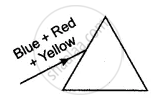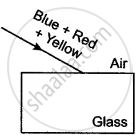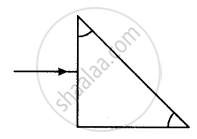Advertisements
Online Mock Tests
Chapters
2: Simple Machines
3: Refraction of Light
4: Refraction through Lenses and Optical Instruments
▶ 5: Spectrum
6: Echoes and Vibrations of Sound
7: Electricity
8: Electric Power and House hold Circuits
9: Magnetic Effect of Current
10: Specific Heat Capacity and Latent Heat
11: Thermionic Emission and Radioactivity
![ICSE solutions for Physics [English] Class 10 chapter 5 - Spectrum ICSE solutions for Physics [English] Class 10 chapter 5 - Spectrum - Shaalaa.com](/images/physics-english-class-10_6:5f2b1b2038084cf381bfa42c826a928c.jpg)
Advertisements
Solutions for Chapter 5: Spectrum
Below listed, you can find solutions for Chapter 5 of CISCE ICSE for Physics [English] Class 10.
ICSE solutions for Physics [English] Class 10 5 Spectrum Short Answers
Light of different colours is deviated through different angles, by a prism. Explain the reason.
Which colour of white light is deviated most.
Which colour of white light is deviated at least?
Give a reason, why the violet colour of white light deviated most and red colour of white light deviated least.
What is understood by the term dispersion of light? What is its cause?
Name the region beyond the red end of the spectrum.
In the atmosphere which colour of light gets scattered the least?
Which characteristic property of light is responsible for the blue colour of the sky?
Write three conditions necessary to obtain a pure spectrum on a screen. Name the instrument in which the conditions stated by you are fulfilled.
Name any two electromagnetic waves which have a frequency higher than that of violet light. State one use of each.
How will you investigate the existence of the radiation beyond the red and violet extremes of the spectrum?
Name the radiations whose wavelength range is from 100 Å to 4000 Å (or 10 nm to 400 nm).
Name two sources of ultraviolet radiation.
How can the presence of ultraviolet radiation be detected?
Name two sources of infrared radiation.
How can the presence of infrared Radiations be detected?
State two properties of infrared radiations which differ from visible light.
State three properties of infrared radiations similar to that of visible light.
Give reason for the following:
Infrared radiations are used as signals during war.
State two properties of ultra-violet radiations which differ from visible light.
State two uses of ultraviolet radiation.
Give reason for the following:
The photographic darkrooms are provided with infrared lamps.
Give reason for the following:
Infrared radiations are used for photography in fog.
State three properties of ultra-violet radiation similar to visible light.
What do you understand by spectrum? Name the seven prominent colours in order, as obtained in the spectrum of white light.
Distinguish between an impure spectrum and a pure spectrum.
Give one use of electromagnetic radiation in Microwaves.
Give one use of electromagnetic radiation in Ultraviolet radiation.
Give one use of electromagnetic radiations in Infrared radiation.
Write the range of wavelength of the visible spectrum.
Write the range of wavelength of the ultraviolet spectrum.
Write the range of wavelength of the infrared spectrum.
Write approximate wavelength for (i) blue (ii) red light. Which colour has the higher speed in a vacuum? Which colour has the higher speed in the glass?
Suggest one way, in each case, by which we can detect the presence of Infrared radiations.
Suggest one way, in each case, by which we can detect the presence of Ultraviolet radiation.
Give one use of infrared radiations.
Name the radiations used for the detection of fracture in bones.
Name the region beyond the violet end of the spectrum called.
Name the radiation of a wavelength longer than 8 × 10−7 m.
State two uses of infrared radiations.
What effect do the ultra-violet radiations have on the human body?
Explain, why quartz prism is required for obtaining the spectrum of ultra-violet light?
Give reason for the following:
A rock salt prism is used instead of a glass prism to obtain the infrared spectrum.
Name the radiations that are used for photography at night.
ICSE solutions for Physics [English] Class 10 5 Spectrum Long Answer
A prism causes dispersion of white light while a rectangular glass block does not. Explain.
ICSE solutions for Physics [English] Class 10 5 Spectrum Figure Based Short Answers
Sunlight entering through a narrow aperture falls on a prism. Draw a neat labelled ray diagram to show the formation of the spectrum on a screen. Name the colour obtained nearer the base of the prism.
In the figure, a beam of light consisting of three colours blue, red, and yellow is incident on a prism and on a rectangular glass block respectively. Complete the diagram by drawings of the refracted and emergent rays.

In the figure, a beam of light consisting of three colours blue, red, and yellow is incident on a prism and on a rectangular glass block respectively. Complete the diagram by drawings of the refracted and emergent rays.

In the diagram, a narrow beam of white light is incident on a right-angled isosceles prism. The critical angle of the material of prism for the yellow colour of white light is 45°. Complete the diagram to show the path of blue, yellow, and red colours of white light till they emerge out of the prism.

Draw a neat diagram to show the arrangement you would use to project a pure spectrum of white light on a screen.
ICSE solutions for Physics [English] Class 10 5 Spectrum Figure Based Long Answers
Comment on the statement: ‘When any ray of white light is incident on a glass prism, it simply disperses it into its seven constituent colours.
An imaginary material reflects red light, scatters green light, transmits blue light, and absorbs yellow, orange, and violet light. A cube of this material is shown in the given diagram.

The surface is illuminated with a beam of white light. What colour will this cube appear?
(i) from above,
(ii) from below and
(iii) from the sides?
ICSE solutions for Physics [English] Class 10 5 Spectrum Short Numerical
What is the wavelength of the wave whose frequency is 1012 Hz? Name the electromagnetic wave.
Solutions for 5: Spectrum
![ICSE solutions for Physics [English] Class 10 chapter 5 - Spectrum ICSE solutions for Physics [English] Class 10 chapter 5 - Spectrum - Shaalaa.com](/images/physics-english-class-10_6:5f2b1b2038084cf381bfa42c826a928c.jpg)
ICSE solutions for Physics [English] Class 10 chapter 5 - Spectrum
Shaalaa.com has the CISCE Mathematics Physics [English] Class 10 CISCE solutions in a manner that help students grasp basic concepts better and faster. The detailed, step-by-step solutions will help you understand the concepts better and clarify any confusion. ICSE solutions for Mathematics Physics [English] Class 10 CISCE 5 (Spectrum) include all questions with answers and detailed explanations. This will clear students' doubts about questions and improve their application skills while preparing for board exams.
Further, we at Shaalaa.com provide such solutions so students can prepare for written exams. ICSE textbook solutions can be a core help for self-study and provide excellent self-help guidance for students.
Concepts covered in Physics [English] Class 10 chapter 5 Spectrum are Deviation Produced by a Triangular Prism, Dispersion of Light Through Prism and Formation of Spectrum, Electromagnetic Spectrum, Colour in White Light with Their Wavelength and Frequency Range, Different Radiation of Electromagnetic Spectrum, Gamma Rays, X rays, Visible Light, Micro Waves, Radio Waves, Scattering of Light and Its Types, Applications of Scattering of Light, Ultraviolet Radiations, Infrared Radiations.
Using ICSE Physics [English] Class 10 solutions Spectrum exercise by students is an easy way to prepare for the exams, as they involve solutions arranged chapter-wise and also page-wise. The questions involved in ICSE Solutions are essential questions that can be asked in the final exam. Maximum CISCE Physics [English] Class 10 students prefer ICSE Textbook Solutions to score more in exams.
Get the free view of Chapter 5, Spectrum Physics [English] Class 10 additional questions for Mathematics Physics [English] Class 10 CISCE, and you can use Shaalaa.com to keep it handy for your exam preparation.
